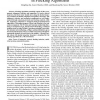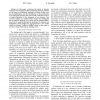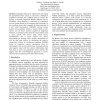130 search results - page 21 / 26 » Mobile robot learning by evolution of fuzzy controller |
ANTSW
2004
Springer
13 years 11 months ago
2004
Springer
This paper addresses the design of control policies for groups of up to 16 simple autonomous mobile robots (called s-bots) for the cooperative transport of heavy objects of differe...
TFS
2008
13 years 7 months ago
2008
Abstract--Flocking algorithms essentially consist of three components: alignment, cohesion, and separation. To track a desired trajectory, the flock center should move along the de...
CEC
2009
IEEE
14 years 2 months ago
2009
IEEE
—In this paper we discuss the notion of situated evolution. Our treatment includes positioning situated evolution on the map of evolutionary processes in terms of time- and space...
ICRA
2002
IEEE
14 years 15 days ago
2002
IEEE
Sampling multisensory information and taking the appropriate motor action is critical for a biological organism’s survival, but a difficult task for robots. We present a Neurally...
GECCO
2008
Springer
13 years 8 months ago
2008
Springer
Legged robots are useful in tasks such as search and rescue because they can effectively navigate on rugged terrain. However, it is difficult to design controllers for them that ...



